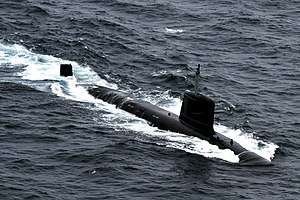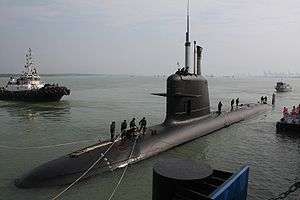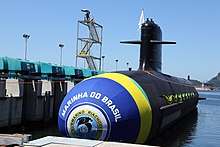Scorpène-class submarine
The Scorpène-class submarines are a class of diesel-electric attack submarines jointly developed by the French Direction des Constructions Navales (DCNS) and the Spanish company Navantia, and now by Naval Group. It features diesel propulsion and an additional air-independent propulsion (AIP).
 Indian Navy's INS Khanderi at sea | |
| Class overview | |
|---|---|
| Name: | Scorpène class |
| Builders: |
|
| Operators: | |
| Preceded by: | Agosta class |
| Subclasses: |
|
| Cost: | US$450 million |
| Built: | 1999–present |
| In commission: | 2005–present |
| Planned: | 18 |
| Building: | 5 |
| Completed: | 9 |
| Cancelled: | 4 |
| Active: | 6 |
| General characteristics | |
| Type: | Submarine |
| Displacement: | |
| Length: |
|
| Beam: | 6.2 m (20 ft 4 in) |
| Draught: | 5.4 m (17 ft 9 in) |
| Draft: | 5.8 m (19 ft 0 in) |
| Propulsion: |
|
| Speed: |
|
| Range: |
|
| Endurance: |
|
| Test depth: | >350 m (1,150 ft)[2] |
| Complement: | 31 |
| Armament: | 6 × 533 mm (21 in) torpedo tubes for 18 Whitehead Alenia Sistemi Subacquei Black Shark heavyweight torpedoes and SM-39 Exocet anti-ship missiles and 30 mines in place of torpedoes |
Scorpène characteristics
The Scorpène class of submarines has four subtypes:[3] the CM-2000 conventional diesel-electric version, the AM-2000 air-independent propulsion (AIP) derivative, the downsized CA-2000 coastal submarine, and the enlarged S-BR for the Brazilian Navy, without AIP.[4]
The Chilean and Malaysian boats are fitted with the TSM 2233 Mk 2 sonar. The class can also be fitted with an 'S-Cube' sonar suite from Thales.[5]
Air-independent propulsion
The French Module d'Energie Sous-Marine Autonome (MESMA) system is being offered by the French shipyard Direction des Constructions Navales (DCNS) for the Scorpène-class submarines. It is essentially a modified version of their nuclear propulsion system with heat being generated by ethanol and oxygen. The combustion of the ethanol and stored oxygen, at a pressure of 60 atm (6.1 MPa), generates steam which powers a conventional turbine power plant. This pressure-firing allows exhaust carbon dioxide to be expelled overboard at any depth without an exhaust compressor.
Each MESMA system costs around US$50–60 million. As installed on the Scorpènes, it requires adding a new 8.3-metre (27 ft), 305-tonne hull section to the submarines, and enables a submarine to operate for more than 21 days under water, depending on variables such as speed.
DCNS is also developing second-generation hydrogen fuel cell AIP modules for future Scorpène models.
Scorpène information leak
In mid-August 2016, The Australian newspaper reported that design details of the Scorpène-class submarine and other ships had been leaked.[6] The leaked information spreads over 22,400 pages and includes detailed information about the submarine's combat and stealth capabilities.[7] The leak also included information about noise levels, submarine frequencies and more.[8] Despite all the information leaks, Indian Navy chief Admiral Sunil Lanba was quoted as saying that the leaks were being viewed "very seriously", but were "not a matter of much worry".[9] The report also suggested that an ex-French Navy officer working as a sub-contractor for DCNS may have been the source of the leak, and that the leaked data may have been written in France in 2011.[10] However, on 30 August 2016, a court in New South Wales temporarily banned The Australian from releasing any more confidential data on the Indian Scorpène-class submarines.[11]
Operators
Chile
.jpg)
The Chilean Navy ordered two Scorpène-class boats, which replaced two Oberon-class submarines retired by the Chilean Navy. The Chilean Scorpène-class O'Higgins and Carrera were completed in 2005 and 2006, respectively.
Malaysia

In 2002, Malaysia ordered two Scorpène-class boats worth US$1.2 billion. Both boats Tunku Abdul Rahman and Tun Abdul Razak commissioned by Royal Malaysian Navy in 2009.
India
_-_1.jpg)
In 2005, India chose the Scorpène design; purchasing six submarines for US$3 billion (US$500 million per boat). Under a technology transfer agreement, the state-owned Mazagon Docks in Mumbai was to manufacture the submarines, and deliver them between 2012 and 2016, however the project is running six years behind schedule.[12][13] Construction started on 23 May 2009.[5] In August 2016, over 20,000 confidential pages of the submarine's manual were leaked by Australian media,[14] stirring up a controversy about the impact to India's ambitions of fielding a blue-water navy.[15]
DCNS answered that those documents were not crucial.[16] After extensive sea trials, Kalvari was commissioned into the Indian Navy on 14 December 2017.[17]
Brazil
.jpg)
In 2009, Brazil purchased four enlarged Scorpènes for US$9.9 billion with a technology transfer agreement and a second agreement to develop a French/Brazilian nuclear-powered submarine. The Brazilian submarine class was given the designation Riachuelo class. The hull of the first S-BR (S40) was laid down at Cherbourg on 27 May 2010 and is to be jumboized at the Brazilian Navy Shipyard in Sepetiba in late 2012.[1] The latter three submarines will be built there entirely, and are planned to be commissioned in 2020, 2021, and 2022. The nuclear-powered submarine Álvaro Alberto is under construction since 2018, with scheduled launch for 2027.[18]
Riachuelo was launched on 14 December 2018, and began sea trials in September 2019.[19]
Potential operators
Spain
In 2003, the Spanish government ordered four Scorpène AIP submarines worth €1,756 million.[20] However, the Spanish navy canceled the order, and ordered four S-80-class submarines, instead. This has caused conflicts and controversies between DCNS and Navantia, as the latter is still involved in the construction of the submarines sold to India, Malaysia, and Chile, while the S-80 is offered on the export market.[21] As an answer to the competition from the S-80, DCNS designed its own enhanced version of the Scorpène called the Marlin class, but little is known about this design and the Scorpène is still offered by France on the export market. The dispute was settled when Navantia gave up export rights on the Scorpène class, leaving DCNS with sole responsibility for the project.[22]
Poland
On 1 March 2011, the Naval Shipyard Gdynia of Poland and DCNS offered a license to build a yet undisclosed number of modified Scorpène-class boats. The Scorpène design is competing with that of the German Type 214 submarine.[23]
Norway
In December 2016, the Norwegian Ministry of Defence announced that Norway would sign a contract for four new submarines before the end of 2019. These would either be Scorpène vessels from DCNS or German U-boats from ThyssenKrupp. Norway would also be looking into possible cooperation on maintenance and construction with other potential buyers of the same submarines, such as Poland or the Netherlands.[24][25] In February 2017, the Norwegian Government announced that it intended to procure its new submarines from the German manufacturer, ThyssenKrupp. Norway and Germany will buy submarines together to mutualize expenses. In practice the tender was cancelled and exclusive government to government negotiations were initiated.
Philippines
In December 2019, Secretary of National Defense of the Philippines Delfin Lorenzana announced that the Scorpène-class submarine of France fits the requirements of the Philippine Navy. Lorenzana saw a Scorpène-class submarine when he visited France. [26] In December 18, 2019, Delfin Lorenzana said that the Philippines is one step closer to acquire the French Submarine after signing an agreement with France sought to enhance both country's martime defense. [27] In January 2020, the Philippine and French Navy conduct expert change on submarine to enhance members in the Submarine's information about the submarine proper. [28]
Boats
| Pennant no. | Name | Country | Laid down | Launched | Commissioned | Homeport |
|---|---|---|---|---|---|---|
| SS-23 | O'Higgins | 18 November 1999 | 1 November 2003 | 8 September 2005 | Talcahuano | |
| SS-22 | Carrera | November 2000 | 24 November 2004 | 20 July 2006 | Talcahuano | |
| - | KD Tunku Abdul Rahman | 25 April 2004 | 23 October 2007 | January 2009 | Sepanggar | |
| - | KD Tun Abdul Razak | 25 April 2005 | October, 2008 | December, 2009 | Sepanggar | |
| S-21 | INS Kalvari | 1 April 2009 | 6 April 2015 [29] | 14 December 2017[17][30] | Vishakhapatnam / Mumbai | |
| S-22 | INS Khanderi | October 2011 | 12 January 2017[31] | 28 September 2019[32][33] | Vishakhapatnam / Mumbai | |
| S-23 | INS Karanj | December 2012 | 31 January 2018[34] | Late 2019 (expected)[32][33][35] | Vishakhapatnam / Mumbai | |
| S-24 | INS Vela[36] | TBD | 6 May 2019[37] | Expected in 2020[35] | Vishakhapatnam / Mumbai | |
| S-25 | INS Vagir[36] | TBD | Expected in 2021[35] | Vishakhapatnam / Mumbai | ||
| S-26 | INS Vagsheer[36] | TBD | Expected in 2022[35][38] | Vishakhapatnam / Mumbai | ||
| S-40 | Riachuelo | 2012 | 14 December 2018[39] | Expected in 2020[40] | Itaguaí | |
| S-41 | Humaitá | 2013 | September 2020 (expected)[41][42] | TBD | Itaguaí | |
| S-42 | Tonelero | 2017 | December 2021 (expected)[41] | TBD | Itaguaí | |
| S-43 | Angostura | 2018 | December 2022 (expected)[41] | TBD | Itaguaí |
Gallery
 Image of Scorpène submarine
Image of Scorpène submarine- Royal Malaysian Navy's submarine at a Navantia shipyard prior to delivery
 Launching of the Brazilian submarine Riachuelo, Scorpène class
Launching of the Brazilian submarine Riachuelo, Scorpène class
See also
References
- Nicolas von Kospot (2 June 2010). "First Steel Cut for Brazilian Submarine Programme". www.defpro.com. Archived from the original on July 17, 2011. Retrieved 7 June 2010.
- "Scorpene® 1000". DCNS. Archived from the original on 15 September 2014. Retrieved 24 October 2015.
- "The Market for Submarines" (PDF). Forecast International. August 2009. Archived from the original on April 17, 2012. Retrieved 13 May 2010.
- "Novas pistas sobre o 'S-BR', o novo submarino convencional Brasileiro". www.naval.com.br. 6 May 2010. Archived from the original on 22 April 2010. Retrieved 13 May 2010.
- "Project 75 – Scorpene SSK". bharat-rakshak.com. Archived from the original on 30 March 2009. Retrieved 28 March 2020.
- Siegel, Matt; Irish, John (24 August 2016). "France's DCNS says India submarine data leak may be 'economic warfare'". Reuters. Archived from the original on 15 July 2017.
- Laskar, Rezaul H (24 August 2016). "Secret data on Indian Navy's Scorpene-class submarines leaked". Hindustan Times. Archived from the original on 26 August 2016.
- Stewart, Cameron (25 August 2016). "What the Scorpene leak reveals". The Indian Express. Archived from the original on 29 August 2016.
- "Scorpene Leak serious, not a matter of worry, says Navy Chief". The New Indian Express. Archived from the original on 2016-08-31. Retrieved 2016-08-30.
- "French ex-naval officer behind Scorpene leak?". The Times of India. Archived from the original on 2016-08-29. Retrieved 2016-08-30.
- Som, Vishnu. "Scorpene Leak: 'The Australian' Can't Release Confidential Data, Says Court". NDTV. Archived from the original on 2016-08-30. Retrieved 2016-08-30.
- Kulkarni, Neha (7 September 2018). "Mazagon Dock to deliver second Scorpene class submarine by year end". the Indian Express. Archived from the original on 5 December 2018. Retrieved 28 December 2018.
- Pandit, Rajat (28 August 2014). "Defence minister Arun Jaitley reviews delayed Scorpene submarine project". The Times of India. Archived from the original on 29 August 2014. Retrieved 24 October 2015.
- Som, Vishnu. "The $3.5 Billion Leak: Scorpene Submarines Exposed, India Assesses Damage". NDTV. Archived from the original on 2016-08-26.
- Joshi, Shashank. "Understanding Scorpene leak: Why India's next-gen subs are now vulnerable". Hindustan Times. Archived from the original on 2016-08-26. Retrieved 2016-08-26.
- Pommier, Sébastien. "Fuite de documents chez DCNS: "Nous sommes en guerre économique"". L'Express (in French). Archived from the original on 2016-08-26. Retrieved 2016-08-26.
- "Scorpene-class submarine Kalvari, built in Mazagon Dock, inducted into Navy". Archived from the original on 2017-12-14. Retrieved 2017-12-14.
- "O Prosub e o submarino nuclear brasileiro SN-BR" (in Portuguese). Poder Naval. 20 February 2018.
- "Submarino Riachuelo inicia provas de mar" (in Portuguese). Poder Naval. 25 September 2019.
- "Scorpene Basic-AIP". Deagel.com. Archived from the original on 23 September 2015. Retrieved 24 October 2015.
- "Scorpène: DCNS et Navantia en instance de divorce". Mer et Marine. Archived from the original on September 29, 2011. Retrieved 2011-12-28.
- Ruello, Alain. "Sous-marins : DCNS et Navantia reprennent leur liberté". Les Echos (in French). Archived from the original on 2017-10-09. Retrieved 2017-02-10.
- Sowula, Sławomir (March 2011). "Gdyńska stocznia chce budować okręty podwodne". Gazeta Wyborcza (in Polish) (2011–03–03). Archived from the original on 7 March 2011. Retrieved 24 October 2015.
- "Nye ubåter - status desember 2016". Norwegian government. Archived from the original on 10 January 2017. Retrieved 9 January 2017.
- "Dette kan avgjøre ubåtkjøpet". aldrimer.no. 9 January 2017. Archived from the original on 10 January 2017. Retrieved 9 January 2017.
- Nepomuceno, Priam; Twitter; Twitter; Twitter (December 3, 2019). "French-made Scorpene submarine ideal for PH: Lorenzana". www.pna.gov.ph. Retrieved 2020-05-07.
- Sadongdong, Marin (December 18, 2019). "PH a step closer to acquiring first submarine". Manila Bulletin.
- Tiamzon, Gaile (January 13, 2020). "France, PHL navies hold expert exchange on submarine". Mintfo. Retrieved 2020-05-07.
- "New India submarine enters water". BBC News. 6 April 2015. Archived from the original on 24 September 2015. Retrieved 24 October 2015.
- "Scorpenes no more". Archived from the original on 2017-03-18. Retrieved 2017-03-20.
- "Second Scorpene class submarine Khanderi to be launched on Jan 12". The Economic Times. Archived from the original on 2017-01-12. Retrieved 2017-01-09.
- "India's second Scorpene-class sub INS Khanderi's induction delayed". The Week. 16 May 2019. Archived from the original on 17 May 2019. Retrieved 27 May 2019.
- "Aero India 2019: India to receive second Scorpene-class submarine by April 2019". Jane's 360. Jane's Navy International. 21 February 2019. Archived from the original on 22 February 2019. Retrieved 22 February 2019.
- "Third Scorpene submarine 'Karanj' Launched at Mazagon Docks". pib.nic.in. Archived from the original on 2018-02-01. Retrieved 2018-01-31.
- "Mazagon Dock to deliver second Scorpene class submarine by year end". The Indian Express. 7 September 2018. Archived from the original on 13 September 2018. Retrieved 12 September 2018.
- "INS Karanj boosts Navy's firepower". The Hindu. Retrieved 2018-01-31.
- "INS Vela: Indian Navy's 4th Scorpene-class made in India submarine launched". Financial Express. Archived from the original on 6 May 2019. Retrieved 6 May 2019.
- Индия одновременно строит шесть подводных лодок типа Scorpene. flotprom.ru (in Russian). 5 May 2012. Archived from the original on 12 January 2016. Retrieved 24 October 2015.
- "Brazil launches first of 5 navy attack submarines". EFE. 14 December 2018.
- Barreira, Victor. "Brazil prepares to launch first Riachuelo-class submarine". janes.com. Archived from the original on 14 August 2019. Retrieved 2018-12-09.
- "LAAD 2017: Brazilian submarine programme moves into construction". IHS Jane's 360. 11 April 2017. Archived from the original on 13 April 2017. Retrieved 10 February 2018.
- "Brazil's second Scorpene sub Humaitá starts move to launch site". Naval Today. 14 May 2019. Archived from the original on 14 May 2019. Retrieved 14 May 2019.